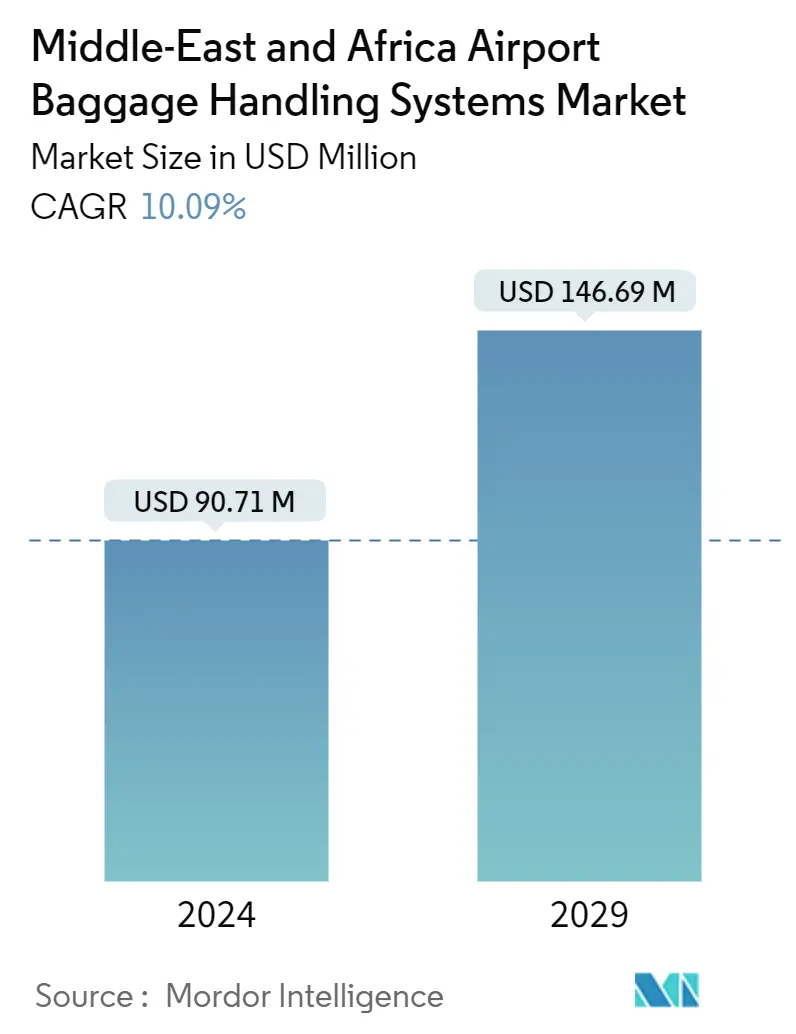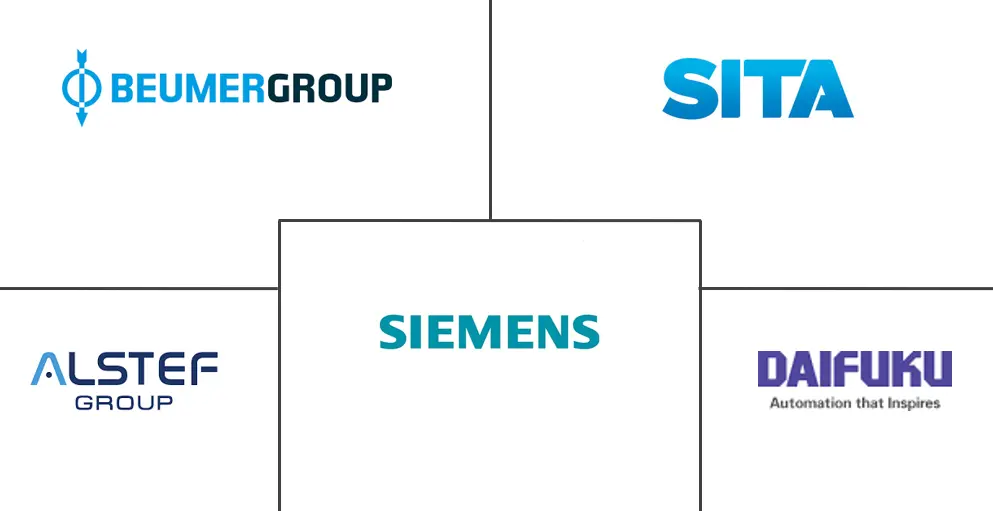Market Size of Middle-East And Africa Airport Baggage Handling Systems Industry

| Study Period | 2019 - 2029 |
| Base Year For Estimation | 2023 |
| Market Size (2024) | USD 90.71 Million |
| Market Size (2029) | USD 146.69 Million |
| CAGR (2024 - 2029) | 10.09 % |
| Market Concentration | Medium |
Major Players
*Disclaimer: Major Players sorted in no particular order |
MEA Airport Baggage Handling Systems Market Analysis
The Middle-East And Africa Airport Baggage Handling Systems Market size is estimated at USD 90.71 million in 2024, and is expected to reach USD 146.69 million by 2029, growing at a CAGR of 10.09% during the forecast period (2024-2029).
The rise in air passenger traffic across the Middle East and African countries, such as Turkey, United Arab Emirates, Ethiopia, and the Republic of Congo, due to the rise in tourism and business travel caused by low airfares and rising standard of living is expected to propel the market growth for new and efficient airport baggage handling systems in the region. According to a report by Airports Council International Asia-Pacific and Middle East, the Middle East witnessed a 26% growth in 2022 compared to 2019.
The construction of new airports and terminal expansion and up-gradation of existing airports in the region will propel the market growth for airport baggage handling systems. Moreover, the advancement in technology and implementation of smart IT solutions in baggage management will boost the market growth in the coming years. On the other hand, high initial and maintenance cost associated with the advanced systems hinders the growth of the market.
MEA Airport Baggage Handling Systems Industry Segmentation
The Middle East and Africa airport baggage handling systems market is a thriving sector that plays a crucial role in the efficient operation of airports in the region. Baggage handling systems are integral to the functioning of airports as they ensure the seamless movement of passenger baggage from check-in counters to aircraft holds and vice versa. These systems encompass various components, such as conveyors, scanners, sorting devices, and tracking technologies, which work together to streamline the baggage handling process.
The Middle East and Africa airport baggage handling systems market is segmented based on airport capacity and geography. By airport capacity, the market is segmented into up to 15 million, 15-25 million, 25-40 million, and above 40 million. By country, the market is segmented into Saudi Arabia, United Arab Emirates, Qatar, Egypt, Turkey, South Africa, and the Rest of the Middle East and Africa.
The market sizing and forecasts have been provided in (USD) for all the above segments.
| Airport Capacity | |
| Up to 15 million | |
| 15 to 25 million | |
| 25 to 40 million | |
| Above 40 million |
| Geography | |
| Saudi Arabia | |
| United Arab Emirates | |
| Qatar | |
| Egypt | |
| Turkey | |
| South Africa | |
| Rest of Middle-East and Africa |
Middle-East And Africa Airport Baggage Handling Systems Market Size Summary
The Middle-East and African airport baggage handling systems market is poised for significant growth, driven by increasing air passenger traffic and the expansion of airport infrastructure in the region. The rise in tourism and business travel, fueled by affordable airfares and improved living standards, is a key factor propelling the demand for advanced baggage handling systems. The construction of new airports and the modernization of existing ones, particularly in countries like Saudi Arabia, Turkey, and the United Arab Emirates, are expected to further boost market growth. Technological advancements and the implementation of smart IT solutions in baggage management are also contributing to the market's expansion. However, the high initial and maintenance costs associated with these advanced systems pose challenges to market growth.
The market is characterized by a semi-consolidated structure, with a few international players such as BEUMER Group GmbH & Co. KG, Siemens Logistics GmbH, SITA, Daifuku Co. Ltd., and Alstef Group (Glidepath Limited) holding significant shares. These companies compete on the basis of product offerings, technological innovation, pricing, and customer service, continually enhancing their products to meet the evolving needs of airports. Strategic partnerships, collaborations, and acquisitions are key strategies employed by these players to expand their market presence and offer integrated solutions. Notable developments in the region include Qatar Airways receiving recognition for its baggage performance and the integration of AI technologies at King Khalid International Airport to improve baggage handling efficiency.
Middle-East And Africa Airport Baggage Handling Systems Market Size - Table of Contents
-
1. MARKET DYNAMICS
-
1.1 Market Overview
-
1.2 Market Drivers
-
1.3 Market Restraints
-
1.4 Porter's Five Forces Analysis
-
1.4.1 Bargaining Power of Suppliers
-
1.4.2 Bargaining Power of Buyers/Consumers
-
1.4.3 Threat of New Entrants
-
1.4.4 Threat of Substitute Products
-
1.4.5 Intensity of Competitive Rivalry
-
-
-
2. MARKET SEGMENTATION
-
2.1 Airport Capacity
-
2.1.1 Up to 15 million
-
2.1.2 15 to 25 million
-
2.1.3 25 to 40 million
-
2.1.4 Above 40 million
-
-
2.2 Geography
-
2.2.1 Saudi Arabia
-
2.2.2 United Arab Emirates
-
2.2.3 Qatar
-
2.2.4 Egypt
-
2.2.5 Turkey
-
2.2.6 South Africa
-
2.2.7 Rest of Middle-East and Africa
-
-
Middle-East And Africa Airport Baggage Handling Systems Market Size FAQs
How big is the Middle-East and Africa Airport Baggage Handling Systems Market?
The Middle-East and Africa Airport Baggage Handling Systems Market size is expected to reach USD 90.71 million in 2024 and grow at a CAGR of 10.09% to reach USD 146.69 million by 2029.
What is the current Middle-East and Africa Airport Baggage Handling Systems Market size?
In 2024, the Middle-East and Africa Airport Baggage Handling Systems Market size is expected to reach USD 90.71 million.

